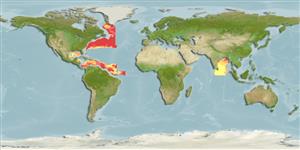Classification / Names
Common names | Synonyms | Catalog of Fishes (gen., sp.) | ITIS | CoL | WoRMS | Cloffa
Actinopterygii (ray-finned fishes) >
Lophiiformes (Anglerfishes) >
Linophrynidae (Leftvents)
Etymology: Linophryne: Greek, 'linon' = flax or anything made of flax such as "cord," "rope," or a "net" + Greek, 'phryne' = "toad" (refers to a toadlike fish that fishes with a net) (Ref. 86949).
Environment / Climate / Range
Ecology
Marine; bathypelagic; depth range 620 - 1220 m (Ref. 86949). Deep-water, preferred ?
Northwestern Atlantic and Southeastern Indian oceans.
Size / Weight / Age
Maturity: Lm ? range ? - ? cm
Max length : 3.0 cm SL male/unsexed; (Ref. 58034); 18.5 cm SL (female)
Short description
Morphology | Morphometrics
Dorsal
soft rays
(total): 3;
Anal
soft rays: 3. Metamorphosed females distinguished by the following characteristics: escal bulb without distal prolongation or filaments;, absence of posterior and anterior appendages; stout, tapering filament on each side of upper part of escal bulb, each one to 1.5 times diameter of bulb; 0-2 minute conical papillae below each lateral filament; undivided primary stem of barbell, length 20-32% SL, distal end divided into a pair of short branches, each with lateral series of 3-4 long filaments, decreasing in length distally and gradually continuing as a cluster of stalked photophores on tip and medial side of each branch; each filament with distal series of internal photophores; length of proximal ang longest filaments 35-65% SL; small branch with internal photophores in cleft between pair of primary branches; dense concentration of subdermal pigment on caudal peduncle of parasitic males; parasitic males with pointed sphenotic spines (Ref. 86949).
Life cycle and mating behavior
Maturity | Reproduction | Spawning | Eggs | Fecundity | Larvae
Pietsch, T.W., 2003. Linophrynidae. Netdevils (deepsea anglerfishes). p. 1069-1070. In K.E. Carpenter (ed.) FAO species identification guide for fishery purposes. The living marine resources of the Western Central Atlantic. Vol. 2: Bony fishes part 1 (Acipenseridae to Grammatidae). (Ref. 58034)
IUCN Red List Status (Ref. 115185)
CITES (Ref. 94142)
Not Evaluated
Threat to humans
Harmless
Human uses
Fisheries: of no interest
More information
Common namesSynonymsMetabolismPredatorsEcotoxicologyReproductionMaturitySpawningFecundityEggsEgg development
Age/SizeGrowthLength-weightLength-lengthLength-frequenciesMorphometricsMorphologyLarvaeLarval dynamicsRecruitmentAbundance
ReferencesAquacultureAquaculture profileStrainsGeneticsAllele frequenciesHeritabilityDiseasesProcessingMass conversion
Tools
Special reports
Download XML
Internet sources
